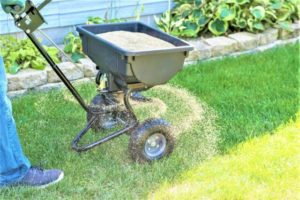
Seeding in October – Soil temperatures are still well into the 70s; we’ve not had a single overnight temperature much below 50; it’s still prime time for seeding/overseeding lawns. Please bear in mind that all meaningful seeding in our growing area should be done in the fall. Warm soil temperatures encourage faster, more complete seed germination; good overnight dews and more regular rainfall (normally) get new seed well established before cold weather arrives. As the ground cools deeper into the fall it cools from the top down, which means that it is always cooler at the surface than 2-3” deep in the soil, which encourages roots to go deeper as they seek warmer soil. Spring, on the other hand, is the complete opposite for seeding: colder soil slows seed germination greatly. Even after germination, roots establish poorly in the cooler soil and remain at the surface where the soil is warmer. The spring seeding season is short followed by summer, with the hardest growing conditions of the year. Spring is for emergency seeding; fall is for meaningful seeding.
Because we’ve had the current dry spell during late August and September, we encourage all of you who either have already seeded or will be seeding to supplement what little moisture we’ve received for good seed germination and establishment. We recommend frequent (daily, if possible) light watering from seeding through germination. This is to keep the seed wet, soften the seed coat and speed germination. After the seed is completely germinated and is growing nicely, water less frequently but more deeply, leaving sprinklers in one spot for 20-30 minutes before moving to other areas. And watering in the morning is best, although watering to promote germination can be done later in the day. And, if we start to get regular rainfall (at least ¾”-1”/week) watering AFTER GERMINATION AND ESTABLISHMENT will not be necessary. The overnight dews will suffice in getting the whole lawn growing nicely.
Broadleaf Weed Control in October – Dandelions and plantain, as well as many other of the cool-warm weather active perennials are still actively growing. They can be easily removed from lawns in October with a single application of TRIMEC liquid herbicide. Warmer weather active weeds like clover and wild strawberry have perceptibly slowed in their growth by now and will be more difficult to eliminate, but in some lawns can be removed. Cool weather active weeds like ground ivy, wild violets, and others are starting to grow actively now, and will be readily controlled by TRIMEC at this time (and into November). It is important to kill perennial weeds in the fall, at the ends of their growing seasons, so we will not be bothered by them in the spring. However, if you have seeded this fall, or plan to seed, we recommend that you NOT apply TRIMEC (or any herbicide) until next spring. Seeding takes precedence in the fall. It’s too late to do a full lawn application of Trimec due to the 2 week waiting period until seeding can take place. You won’t get complete germination and plant establishment before the cold weather arrives. If you fall into this category, remember next year to apply TRIMEC in the late-August to mid-September window where you can treat weeds, wait 2 weeks and still seed with best results.
Fertilizing Lawns in October – It is key that any lawn fertilizer applied in October not be the last feeding of the year. We strongly recommend two fall feedings for all lawns: early fall AND late fall. Of the 2, the late fall WINTERFEAST feeding is by far the more important for the lawn. It is intended to subtly green the lawn before dormancy, but is primarily to promote root growth after the above-surface turf has gone almost dormant. This will keep the lawns green until the ground freezes, will stimulate deeper and denser root growth this winter, and will green the lawn early next spring without pushing lots of top growth. Having said that, and if you haven’t yet fed your lawn this fall, you should a.) feed it right away, with our early fall fertilizer (19-2-6) and feed again, with WINTERFEAST fertilizer after Thanksgiving, or b.) withhold feeding until late October or early November, and then apply your WINTERFEAST fertilizer.
Liming in October – All lawns in this region benefit from being limed every year in order to neutralize the inherent soil acidity we are blessed with. Liming regularly makes fertilizers work better by making the full affect of the nitrogen, phosphorous and potassium more readily available to the grass plants. In acidic soils, both macro (NPK) and micronutrients react chemically with the low pH of the soil and create compounds that bind them to the soil thus making them less available to the plants. You get less greening power, less root development, less fertilizer effectiveness.
Mowing and Leaf Removal – Do not put mowers away yet. The grass is still growing, and will continue to grow for at least another 2 months, albeit less fast as temperatures fall. Our objective with lawns is to have all lawns mowed closely (2.5”-3”) when it goes dormant for the winter season. So, keep mowing every week to ten days until after Thanksgiving. If lawns are long when winter sets in, the late falling leaves and snow falling will mat the grass down and encourage dormant diseases and an early spring mess. Another reason to continue mowing through November is that leaves will continue to fall through November, which can be detrimental to newly established and mature grass plants. By mowing regularly (at least every 7-10 days) you’ll be chopping up the leaves that fall or blow onto the lawn, thus keeping the turf upright, tight and clear.
